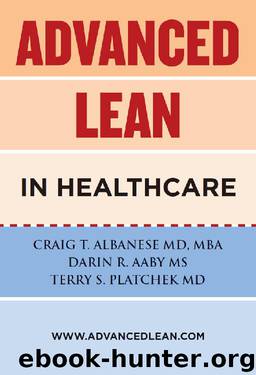Advanced Lean In Healthcare by Craig Albanese MD & Darin Aaby & Terry Platchek

Author:Craig Albanese MD & Darin Aaby & Terry Platchek [Albanese MD, Craig]
Language: eng
Format: epub
Published: 2014-10-15T04:00:00+00:00
LEAN TERM TRANSLATION
Value Stream Care Pathway
Standard Work Leading Practice
Waste Inefficiency
Defect Error that reaches patient
Gemba Clinic, operating room, ward
A3/PDCA Scientific method
Overproduction Prep for patients who don’t show
Inventory Patients waiting, backlog of supplies or appointments
Table 5.3: Deciphering Lean Terms for Physicians
The patient’s journey is viewed with a different lens in the lean culture versus the physician culture. Physicians principally work in a silo; their interactions with their patients are an “inch wide and a mile deep.” Although healthcare is increasingly complex and a patient’s care relies on teamwork among many practitioners, practitioners view their role in the patient’s journey as narrow. Conversely, lean management looks at the patient in the same way that patients view their own navigation through the healthcare system: in a longitudinal fashion (the value stream view). Patients stream through the system by intersecting with many silos including physicians, nursing, and information technology experts. The processes that intersect these silos often produce a suboptimal patient experience. This does not mean that physicians should not demand and retain deep content expertise in their silo. It means that they need to understand how decisions made in one silo may or may not affect another and ultimately the patient. It is these “between-silo” processes that are often broken or misaligned and where healthcare can use assistance from physicians.
Lean aims for zero quality defects. Nothing else is tolerated. As an example, high-reliable industries such as nuclear power and commercial aviation operate at around a six sigma defect ratio (3.4 defects per million events). Healthcare is presently around two to three sigma for defects. We tolerate defective processes. We employ work-arounds and quick fixes but rarely solve problems at their root or, better yet, by mistake proofing systems. We speculate that this is, in part, due to the sentiment that defects or mistakes in the physician culture are taboo. Physicians are held to standards that approach infallibility by society, and they hold themselves to those unattainable standards. We strive for perfection with patient care but don’t apply the same rigor to process problem solving.
Finally, the practice of medicine is steeped in the “solitary artisan” culture. It has evolved from a pure practice of an “art” to one that requires a combination of artistic cognitive assimilation of data based on pattern recognition, experiential learning, and evidence-based methods. However, the physician culture is often resistant to lean systems, because the lean culture places emphasis on the science of medicine by espousing clinical standardized work—often misinterpreted by physicians as “cookbook medicine.” As mentioned earlier, lean vocabulary is obscure to newcomers, and the term “standardized work,” if not properly explained, may be off-putting for physicians. Physicians value using their critical thinking skills in service to their patients. They don’t want to practice cookbook medicine or have someone outside of the profession tell them how to best care for their patients.
If standardized work is explained to physicians as the “best way we (the collective evidence base) know now to practice and to reliably produce desired results,” resistance will melt away.
Download
This site does not store any files on its server. We only index and link to content provided by other sites. Please contact the content providers to delete copyright contents if any and email us, we'll remove relevant links or contents immediately.
Good by S. Walden(3485)
The Social Psychology of Inequality by Unknown(2937)
0041152001443424520 .pdf by Unknown(2784)
The Checklist Manifesto by Atul Gawande(2776)
The Meaning of the Library by unknow(2503)
Guns, Germs and Steel by Diamond Jared(2303)
Borders by unknow(2227)
23:27 by H. L. Roberts(2195)
And the Band Played On by Randy Shilts(2127)
Get What's Yours for Medicare: Maximize Your Coverage, Minimize Your Costs by Philip Moeller(2086)
Being Mortal: Medicine and What Matters in the End by Atul Gawande(2081)
A Leg to Stand On by Oliver Sacks(2004)
The Hot Zone by Richard Preston(1983)
The Valachi Papers by Peter Maas(1810)
The Laws of Medicine by Siddhartha Mukherjee(1754)
The Andromeda Strain by Michael Crichton(1696)
The Obesity Epidemic by Robyn Toomath(1644)
Pharmacy Practice and The Law by Richard Abood(1541)
Autism's False Prophets by Paul A. Offit(1495)
